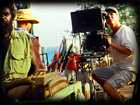|
|
|||||||||||||
 the
start I
the casting
I
the boys I
the shoot Even so, finding a person with the knowledge didn't always mean the problem was solved, as there was film time and Yolngu time. Despite the best efforts of the crew it wasn't always possible to convey the urgency of keeping to schedule -- especially crucial for a shoot on a stringent budget. "They have no concept of time," laughed Johnson. "They just don't care about it. I suppose our tendency to agonize over deadlines must seem strange to a culture that's been in existence for more than fifty thousand years. You must also appreciate that the concept of what's involved in making a movie is totally alien to them, but I have to say that the women are just amazing. They just get things done and the local ladies helped the art department produce many of the items we needed." The large paintings required for the scene where an out-of-control Botj stumbles through the church before setting the community centre ablaze, were a prime example, being executed by two local artists, Gaymala and Bundaman. Props such as Lorrpu's Banyan rope would also have been virtually impossible to create without local help. It's one thing knowing that such a rope is made from the vines of the Banyan tree but attempting to craft one without the right technique would have been futile. Likewise with 'Gappan,' worn at times by Lorrpu throughout the boys' trek. Derived from the soil and mixed with water to obtain the right consistency, Gappan is a clay-like substance that varies from community to community but in the hands of a novice could resemble a mud pie. |
|||||||||||||

